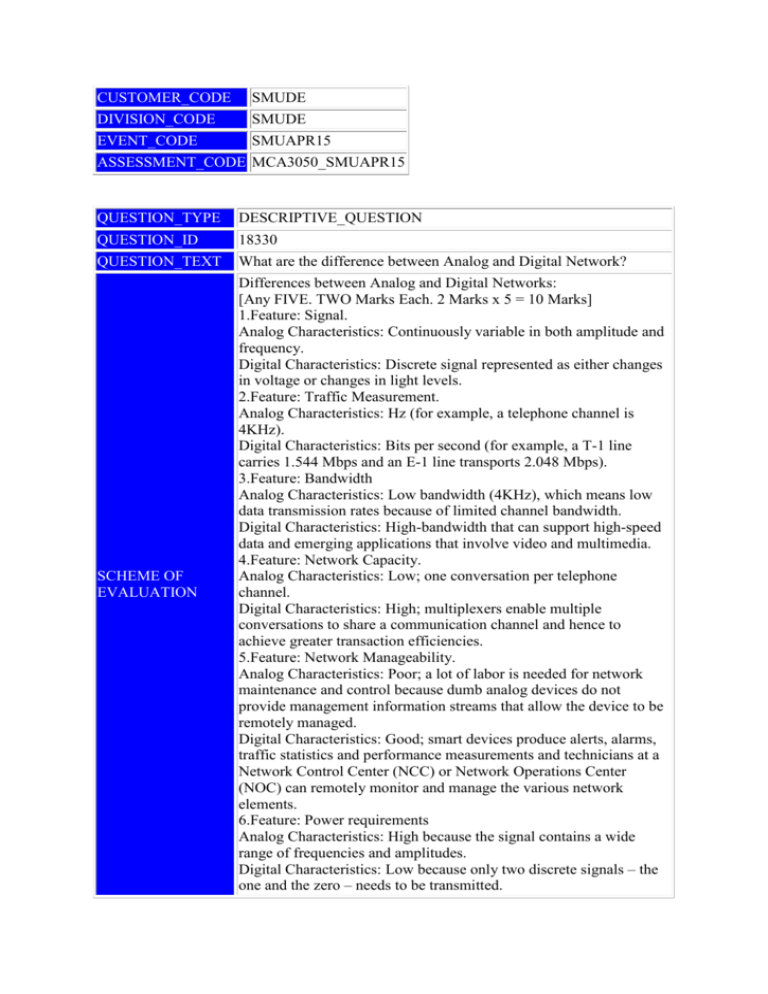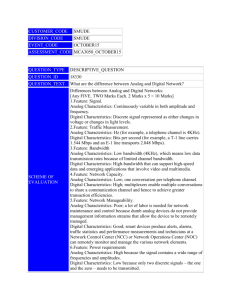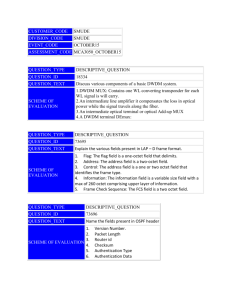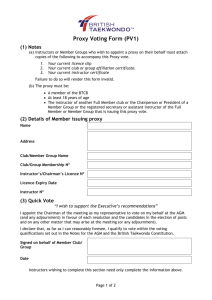CUSTOMER_CODE SMUDE DIVISION_CODE SMUDE
advertisement

CUSTOMER_CODE SMUDE DIVISION_CODE SMUDE EVENT_CODE SMUAPR15 ASSESSMENT_CODE MCA3050_SMUAPR15 QUESTION_TYPE DESCRIPTIVE_QUESTION QUESTION_ID 18330 QUESTION_TEXT What are the difference between Analog and Digital Network? SCHEME OF EVALUATION Differences between Analog and Digital Networks: [Any FIVE. TWO Marks Each. 2 Marks x 5 = 10 Marks] 1.Feature: Signal. Analog Characteristics: Continuously variable in both amplitude and frequency. Digital Characteristics: Discrete signal represented as either changes in voltage or changes in light levels. 2.Feature: Traffic Measurement. Analog Characteristics: Hz (for example, a telephone channel is 4KHz). Digital Characteristics: Bits per second (for example, a T-1 line carries 1.544 Mbps and an E-1 line transports 2.048 Mbps). 3.Feature: Bandwidth Analog Characteristics: Low bandwidth (4KHz), which means low data transmission rates because of limited channel bandwidth. Digital Characteristics: High-bandwidth that can support high-speed data and emerging applications that involve video and multimedia. 4.Feature: Network Capacity. Analog Characteristics: Low; one conversation per telephone channel. Digital Characteristics: High; multiplexers enable multiple conversations to share a communication channel and hence to achieve greater transaction efficiencies. 5.Feature: Network Manageability. Analog Characteristics: Poor; a lot of labor is needed for network maintenance and control because dumb analog devices do not provide management information streams that allow the device to be remotely managed. Digital Characteristics: Good; smart devices produce alerts, alarms, traffic statistics and performance measurements and technicians at a Network Control Center (NCC) or Network Operations Center (NOC) can remotely monitor and manage the various network elements. 6.Feature: Power requirements Analog Characteristics: High because the signal contains a wide range of frequencies and amplitudes. Digital Characteristics: Low because only two discrete signals – the one and the zero – needs to be transmitted. 7.Feature: Security Analog Characteristics: Poor; when you tap into an analog circuit; you hear the voice stream in its native form, and it is difficult to detect an intrusion. Digital Characteristics: Good; encryption can be used. 8.Feature: Error rates. Analog Characteristics: High; 10 -5 bits (that is 1 in 100,000 bits) is guaranteed to have an error. Digital Characteristics: Low; with twisted-pair, 10 -7 bits (that is 1 in 10 million bits per second) will have an error, with satellite 10 -9 (that is 1 in 1 billion bits per second) will have an error, 10 -11 (that is 1 in 10 trillion bits per second) will have an error. QUESTION_TYPE DESCRIPTIVE_QUESTION QUESTION_ID 73695 QUESTION_TEXT Explain the various fields present in LAP – D frame format. SCHEME OF EVALUATION 1. Flag: The flag field is a one-octet field that delimits. 2. Address: The address field is a two-octet field. 3. Control: The address field is a one or two octet field that identifies the frame type. 4. Information: The information field is a variable size field with a max of 260 octet comprising upper layer of information. 5. Frame Check Sequence: The FCS field is a two octet field. QUESTION_TYPE DESCRIPTIVE_QUESTION QUESTION_ID 73696 QUESTION_TEXT Name the fields present in OSPF header 1. 2. 3. SCHEME OF EVALUATION 4. 5. 6. Version Number. Packet Length Router id Checksum Authentication Type Authentication Data QUESTION_TYPE DESCRIPTIVE_QUESTION QUESTION_ID 73697 QUESTION_TEXT Briefly explain the different Queue Management Algorithms SCHEME OF EVALUATION 1. Different Queue Management Algorithms: FIFO Algorithm: The heart of this algorithm lies in that if overload occurs, packets are placed onto a single common queue and retrieved from it according to other order in which they arrived- that is first in first out. In all packet switching devices, the FIFO algorithm is used by default. (2 marks) 2. Priority Queuing: These types of algorithms are popular in many areas of computing – for example multitasking operating systems, where certain applications must priority over others. These algorithms are also used for priority queuing, when some classes of traffic must have priority over others. The priority-queuing is based on dividing all network traffic into a small number of classes and assigning some numeric characteristics, known as priority to each class. (2 marks) 3. Weighted Queuing: This algorithm is developed to provide certain minimum bandwidth to all classes of traffic, or at least to guarantee observations of some requirements to delays. Class weight is the percentage of the total bandwidth of the resource that is guaranteed to this class of traffic. Like priority queuing, weighted queuing requires the division of the traffic into several classes. For each class, a separate queue is created. However in weighted queuing each queue is assigned the percentage of the resource bandwidth guaranteed to this class under conditions of resource overload rather than a specific priority. For input flow, role of resource is played by the processor, and for the output flow, this role is played by the output interface. (3 marks) 4. Hybrid Algorithm of Queuing: Both of the two algorithms (priority and weighted) has some advantages and drawbacks. A hybrid algorithm is trying to find a compromise between those two algorithms. The most popular type of such an algorithm uses one priority queue and serves all other queues according to the weighted algorithm. Usually priority queues are used for real-time traffic and other queues are used for elastic traffic of several classes. Each class of elastic traffic get some guaranteed minimum of the bandwidth during congestion periods. This minimum is calculated as percentage of the bandwidth remaining after serving the priority traffic. However, it is necessary to limit the priority traffic somehow to prevent it from consuming the entire bandwidth of the resource. (3 marks) QUESTION_TYPE DESCRIPTIVE_QUESTION QUESTION_ID 125314 QUESTION_TEXT What are the Different layers in internet model? Explain each one. There are four layers in internet model. (2 Marks) SCHEME OF EVALUATION 1. Host-to-network/link layer 2. Internet layer 3. Transport layer 4. Application model Explanation on each layer (Each carry 2 Marks) Host-to-network/link layer: It is a interface between hosts and transmission links. It supports all standard and proprietary protocols Internet layer: The main responsibility of this layer is to permit hosts to inject packets into any network and have travel autonomously to the destination. Transport layer: It is designed to allow peer entities on the source and destination hosts to carry on a conversation. Application layer: This contains all higher level protocols such as DNS, HTTP, FTP, SMTP etc. QUESTION_TYPE DESCRIPTIVE_QUESTION QUESTION_ID 125317 QUESTION_TEXT Define Proxy Server. Explain different types of Proxy. 1. 2. SCHEME OF EVALUATION 3. 4. In computer networks, a proxy server is a server (a computer system or an application) that acts as an intermediary for requests from clients seeking resources from other servers. A client connects to the proxy server, requesting some service, such as file, connection, web page, or other resource available from a different server. The proxy server evaluates the request as a way to simplify and control their complexity. (2 marks) Different types of proxy: Forward Proxy: Forward Proxies are Proxies where the client server names the largest server to connect to. Forward “roxies are able to retrieve from a wide range of resources. (2 marks) Open Proxy: An Open Proxy is a forwarding proxy server that is accessible by any Internet user. (1 mark) Reverse Proxy: A Reverse Proxy (or surrogate) is a proxy server that appear to clients to be an ordinary server. Requests are forwarded to one or more origin servers which handle the request. The response is returned as if it came directly from the proxy server. Reverse Proxies are installed in the neighborhood of one or more web servers. All traffic coming from the Internet and with a destination of one of the neighborhood’s web server goes through the proxy server. The use of “reverse” originates its counterpart “forward proxy” since the reverse proxy sits closer to the web server and servers only a restricted set of websites. Figure below shows different types of proxies: (5 marks) (Diagram not required)








